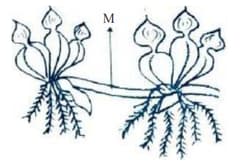EASY
Earn 100
Ginger is a
(a)Bulb
(b)Tuber
(c)Rhizome
(d)Corn
100% studentsanswered this correctly
Important Questions on Morphology of Flowering Plants
HARD
Taeniophyllum, Casuarina, Asparagus, Bougainvillea, Dioscoria, Opuntia, Hibiscus, Chrysanthemum
EASY
EASY
EASY
EASY
EASY
| LIST-I | LIST-II | LIST-III | |||
| A | Atropa | i | Ormament | I | Number and codes |
| B | Computer usage in taxonomy | ii | Medicine | II | Pterocarpus |
| C | Gloriosa | iii | Fabaceae | III | Solanaceae |
| D | Odd sepal anterior | iv | Numerical Taxonomy |
IV | Rhizome |
The correct match is:
EASY
MEDIUM
EASY
Identify the vegetative propagule in the following diagram:

EASY
MEDIUM
The transverse section of a plant shows following anatomical features:
(a) Large number of scattered vascular bundles surrounded by bundle sheath
(b) Large conspicuous parenchymatous ground tissue
(c) Vascular bundles conjoint and closed
(d) Phloem parenchyma absent
Identify the category of plant and its part:
EASY
MEDIUM
Identify group of plants based on given anatomical characters in sequence.
Bicollateral vascular bundles
Bulliform cells
Ring arrangement of vascular bundles
Answers respectively
MEDIUM
A) A bud is present in the axil of leaflets of the compound leaf.
B) Casuarina has limited growth of branches as phylloclades.
C) Sub aerial stem of Oxalis spread to new niches when old parts die.
D) Pericarp and seed coat fuse together in caryopsis.
MEDIUM
HARD
Find the correct match:

HARD
In Mimosa pudica, thigmotropism helps in protection, whereas in bitter-guard tendrils help in _____.
HARD
Trap leaves supply nitrogen to Nepenthes plant
Grape vines differ from watermelon by having tendrils developed from axillary bud
Balancing roots of Eichornia arise from horizontally growing lateral branches
Gall flowers of Ficus store eggs of Blastophaga
MEDIUM
EASY

